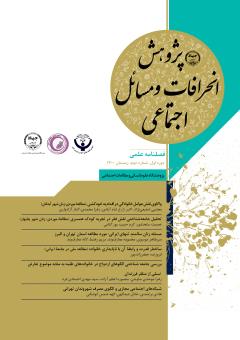تحلیل جامعهشناختی نقش فقر در تجربۀ کودکهمسری (مطالعۀ موردی: زنان شهر چابهار)
محورهای موضوعی : Social issues and injuries related to women and the familyعصمت سلحشور 1 , کرم حبیب پور گتابی 2
1 - دانشآموخته کارشناسی¬ارشد پژوهش علوم اجتماعی، دانشگاه خوارزمی تهران، ایران
2 - دانشيار گروه جامعه¬شناسی، دانشگاه خوارزمي، ایران
کلید واژه: مسئله اجتماعی, کودک¬همسری, چهرۀ زنانه فقر, فقر مضاعف و انزوای اجتماعی. ,
چکیده مقاله :
ازدواج دختران در دوران کودکی، چالشی در مناطق کمتر توسعه یافته و مسئلهای اجتماعی است که در بخش های مختلف جهان، زندگی زنان و کودکدختران را تحت تأثیر قرار داده است. هدف این پژوهش، تفسیر دلایل زنان شهر چابهار از تجربۀ کودک همسری است که با روش شناسی کیفی و با استفاده از روش نظریۀ زمینه ای انجام شده است. پژوهش حاضر با ابتنای بر روش نظریۀ زمینه ای، به درک معنای ذهنی 28 نفر از زنان شهر چابهار نسبت به تجربۀ کودک همسری و شرایط علی، مداخله ای و بافتی در بازنمایی تجربه زیستۀ کودک همسری مبتنی بر فقر پرداخته است. به این منظور با 28 نفر از زنان شهرستان چابهار که به روش نمونه گیری نظری انتخاب شده بودند، مصاحبه های عمیق و نیمه ساختار یافته انجام شد. فقر اقتصادی، فقر فرهنگی-آموزشی، شرایط نابسامان خانوادگی و تبعیض جنسیتی، شرایط علّی ازدواج دختران در سنین کودکی را فراهم ساخته است. شرايطه مداخلهگر (فقر زنان سرپرست خانوار و چهرۀ زنانه فقر) و شرايط بافتي (فقر شهری، زیست مکان ناامن و مردسالاری هنجاری) نيز ازدواج کودکان را زمينهسازي و تسهيل کرده است. همچنین تحليل دادهها با نظام کدگذاري سهسطحي باز، محوري و گزينشي نشان داد که مقولۀ مرکزي منتزع از ازدواج کودکان در بين افراد مورد مطالعه، «فقر مضاعف و کودک همسری چندوجهی» است. یافته ها بر این دلالت داشتند که ازدواج در کودکی، دختران را در معرض انوع آسیب های آشکار و غیر مستقیم از جمله کودک مادری، کودک بیوه گی، خشونت خانگی، بازماندگی تحصیلی، بازتولید چرخۀ فقر، افسردگی مفرط و انزوای اجتماعی قرار می دهد.
Marriage of young girls during childhood is a social issue which has affected the lives of women and young girls in different parts of the world. The aim of this research is to discover the interpretations and rationales of the women in the city of Chabahar regarding their experience of child marriage through a qualitative methodology and Grounded Theory approach. To this end, using a theoretical sampling method, 28 young girls in Chabahar County were chosen and deep and semi-structured interviews were carried out with them. The categories that provided the causal conditions for the marriage of young girls during childhood years were financial poverty, cultural/educational poverty, unfavorable family circumstances, and gender discrimination. In addition, interventional conditions (poverty of female heads of household, and the femininity of poverty) and contextual conditions (urban poverty, unfriendly living environments, and normalized patriarchy) have become a background for and facilitated the marriage of young girls. Moreover, data analysis using open, axial, and selective coding showed that the central category abstracted from the marriage of young girls in the sample is “extreme poverty, and multifaceted child marriage”. The findings implied that child marriages expose young girls to different kinds of obvious and indirect distressful situations, including child motherhood, child widowhood, domestic violence, dropping out of school, reinforcement of the cycle of poverty, severe depression, and social isolation.
